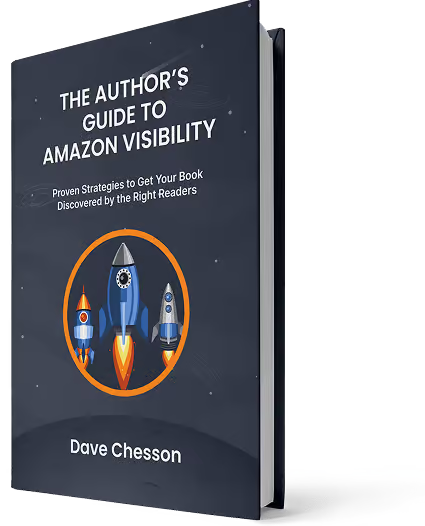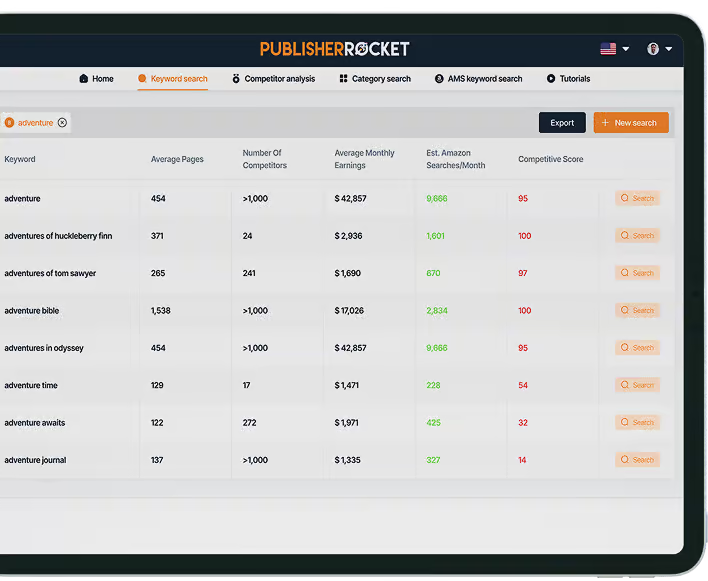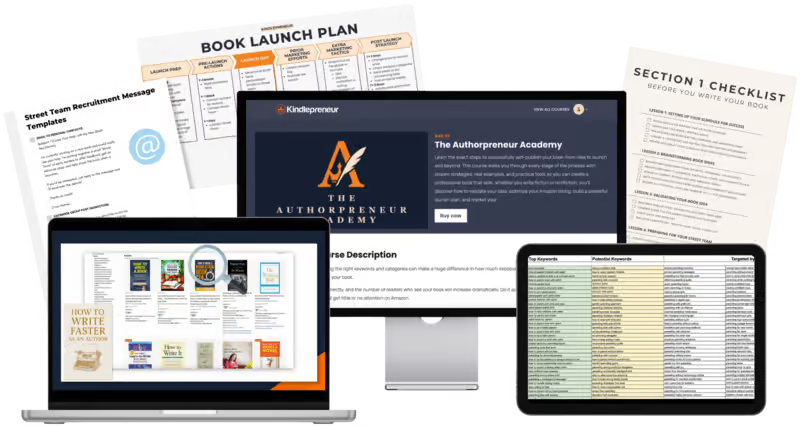AI writing tools seem to multiply by the week, each one claiming it can take your words (and your workload) to the next level.
Sudowrite is one that’s been on the radar of a lot of fiction authors lately. It promises a deep toolbox for brainstorming, drafting, and polishing your prose. But does it actually deliver on those promises, or is it just another shiny distraction?
If you want my quick verdict: for fiction writers dipping their toes into AI for the first time, Sudowrite stands out as the most capable, well-rounded option I’ve tested. Its feature set is broad, but the real star is its own fine-tuned Muse model, which is one of the strongest language models I’ve seen for producing imaginative, engaging prose.
It’s not without its flaws, though, so let’s dig into what works, what doesn’t, and whether it’s a good fit for your writing process.

I've put together a list of prompts that you can use for just that purpose!
Check them out here:
Additionally, if you'd like to know more about how author can leverage AI, I'd invite you to check out my Story Hacker community, where we have dedicated teachers on various topics, including AI writing tools like this one.
A Note on Reviewing AI Tools
A common fear among writers is that AI will eventually churn out books without us. Press a button, get a finished novel.
That’s not where we are, and frankly, I doubt we’ll get there anytime soon. Even if the technology could produce a coherent story in seconds, I believe readers would still crave the spark that comes from a human imagination.
Right now, AI writing tools are more like productivity sidekicks than replacements. They excel at the supporting tasks (brainstorming, rephrasing clunky lines, catching typos), so you can save your creative energy for character arcs, plot decisions, and worldbuilding.
The best analogy I’ve heard is that AI is to writing what calculators are to math: they handle the tedious bits so you can focus on solving the bigger problems.
For me, an AI tool earns its keep if it lightens my mental load. Writing fiction can be mentally exhausting, and having AI help with small, repetitive jobs often means I write for longer stretches and enjoy it more. It’s also a game-changer for writers with certain disabilities or energy limitations.
What I Look For
Here’s my personal checklist when evaluating any AI tool:
- User Experience: Does the interface guide you through the process without friction?
- Accuracy: How close does the AI output come to what I asked for? This often depends more on the underlying language model than the software’s interface.
- Peace of Mind: Even if it doesn’t drastically cut my writing time, does it make the process less mentally draining? That relief alone is worth a lot.
With that framework in mind, let’s see how Sudowrite measures up (and whether it actually helps reduce creative fatigue).
What is Sudowrite?
Sudowrite is primarily an AI writing and editing software. And this alone is nothing big. There are tons of AI tools out there, but this is one of the few that is specifically geared for fiction authors.
Sudowrite has various features, from the Story Bible which helps you catalogue all of the elements of your novel (and stores them in a way in which the AI can access the data when it writes), to a bunch of brainstorming features, and a lot of other tools that let you edit the manuscript as you go.
In fact, it's kind of packed with features.
On my own personal YouTube channel (a side-project not affiliated with Kindlepreneur but posted here with permission), I did a complete walkthrough of the software and how it works. See here:
If you want more videos like this talking about the practical uses of AI in writing and marketing, be sure to subscribe to the channel.
Pricing: How Much Does Sudowrite Cost?

Sudowrite has three pricing tiers that you can purchase at a monthly rate, or annually for a slightly lesser fee.
- Hobby & Student – $19/month (or $10/month when billed annually) for 225,000 credits/month.
- Professional – $29/month (or $22/month when billed annually) for 1,000,000 credits/month.
- Max – $59/month (or $44/month when billed annually) for 2,000,000 credits/month.
Compared to a variety of other AI tools out there, this comes in roughly middle of the road. It’s not as cheap as Novelcrafter or RaptorWrite, but it’s far better for the number of words you get than a nonfiction tool like Jasper or CopyAI.
Keep in mind that Sudowrite operates on a “credit” system, meaning that every time you generate words with AI, it will spend credits. Less expensive LLMs will use fewer credits, whereas larger models will use more.
Of those options, I personally recommend the middle “Professional” plan at $29/month or $300/year. It has the best value. Although if you're a power-user of AI, the $59/month “Max” option is nice because the credits rollover.
Is there a free version of Sudowrite?
There is not a permanently free version of Sudowrite, but if you use Kindlepreneur's special link, you can actually get 10,000 free AI generated words. That is plenty to try it out for yourself.
How to Use Sudowrite
There are a LOT of features that Sudowrite offers, so many that I’ve decided to group many of them together and talk about each in a bulleted list. Hopefully this will help you wrap your mind around the many different options Sudowrite gives you.
Muse
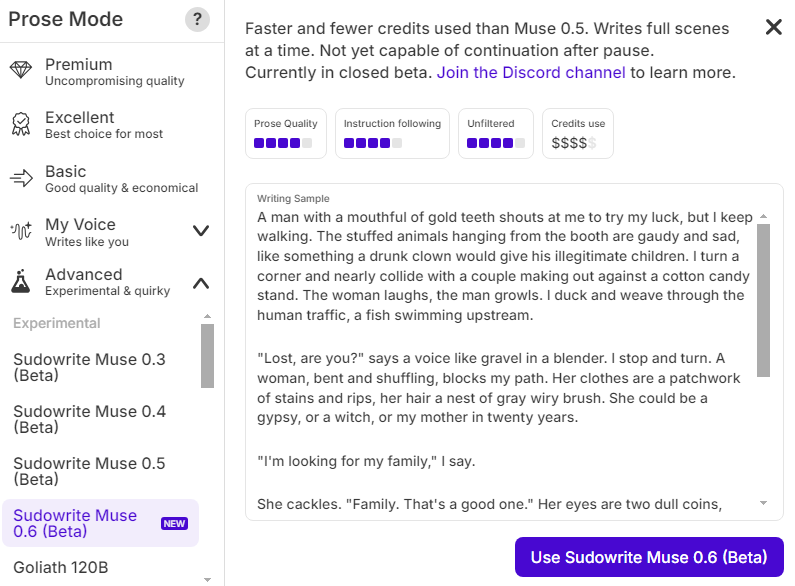
By far the most important flagship feature that Sudowrite offers is their Muse model, a Large Language Model (LLM) that has been specifically designed and fine-tuned for creative writing.
Your mileage may vary, but from my own experience with it, it's the best model I've ever worked with for that specific purpose.
As of mid-2025, the Muse model is publicly available, not just in private beta. It now powers key features like Draft (formerly Chapter Generator), Write (Guided and Auto Write), Expand, and Synopsis in Story Bible.
The Muse model has an intuitive understanding of a scene like no other AI I've worked with, including an understanding of blocking, good dialogue, witty humor, and just overall amazing prose.
It's by far, I think, the number one reason why a subscription to Sudowrite is worth it.
The Writing Tools

First, let’s start with what most people are probably interested in: the writing tools. These are the tools that are best for longer-form writing.
In other words, if you’re hoping to use Sudowrite to actually help you write the first draft of your manuscript, this is what you want to look at.
- Chapter Generator: This is a feature where AI can take a detailed summary of your chapter (usually in the form of 10-20 beats), and write out the whole thing. Personally, I've found this to be a bit hit or miss, and I prefer to write my chapters one 250-word section at a time or so, but it's actually quite a useful tool if you want a quick draft ready to edit.
- Guided and Auto Write: These two options are how you continue writing each subsequent section of your story. With Guided Write, you can add a sentence or two about what happens next, and Sudowrite will take that and generate up to 500 words (depending on your settings). Auto Write is similar, but without the guidance, meaning you can just see where it goes. Combined with the Muse model, these are my favorite ways to write.
- Tone Shift: This is a handy feature that allows you to change the tone of your story. A pretty simple but often needed feature.
- Expand: Let’s say you have a paragraph that quickly covers some action, and you want to expand that moment to include more detailed descriptions, or perhaps more dialogue, etc. The Expand feature is perfect for that. It’s probably the feature I use most after Guided Write.
Revision Tools

Revision is one of those things that AI is pretty good at these days, and you can see that in action with these tools. These are the tools I will often use once I already have my manuscript in decent shape, or after importing my own manuscript from elsewhere.
- Rewrite: The Rewrite feature is one of my favorites. It lets you rewrite any text to either Rephrase the text, make it shorter, more descriptive, to show instead of tell, add more inner conflict, or make the text more intense. I especially love using the “Show not Tell” feature, since AI often tells too much, I can easily select those passages and fix them. You can also customize your Rewrite to conform to any specific prompts you might want to give it.
- Describe: I’m personally horrible at descriptions. They say you should try to use as many senses as possible when describing, but I’m barely able to get one. With Sudowrite, you can highlight a section you want to describe in more detail, and it will do so using all five senses, plus some metaphors. This is a very useful tool for expanding my descriptions.
Brainstorming Tools

Here is one area where Sudowrite shines. They have a ton of different ways to brainstorm your novel or different elements of it.
The way each of these work is the AI will generate a list of things like names, dialogue, attributes, etc. It’s a giant list builder, and it does so in each of the following categories:
- Dialogue
- Characters
- World Building
- Plot Points
- Names
- Places
- Objects
- Descriptions
- Article Ideas
- Tweets
- Something Else (a custom field where you can ask the tool to brainstorm just about anything)
I’ve found these to be very useful, if only to get my creative juices flowing. I might not even use the items I’m given, but sometimes I’ll pick a piece of one, combine it with something else, and have a much better idea of what I want.
Overall a great tool.
Plugins
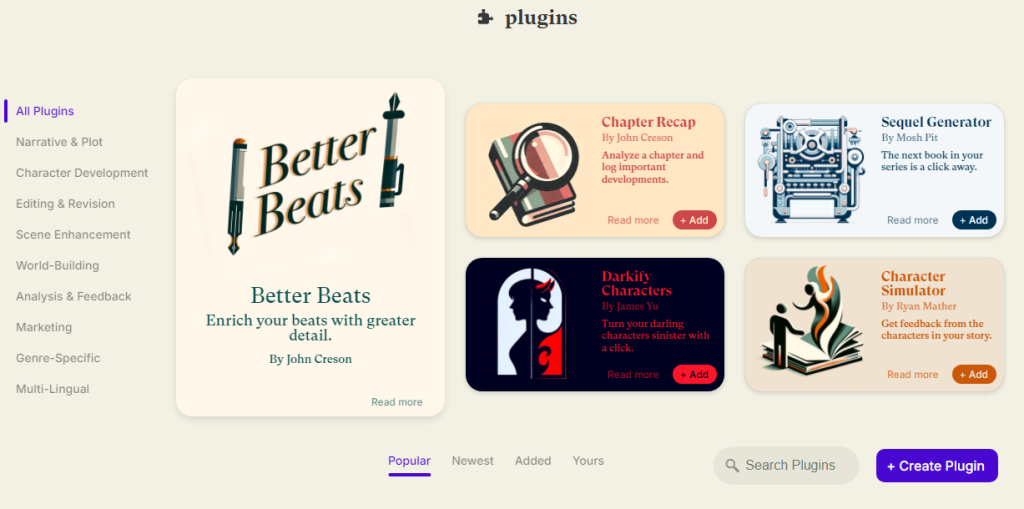
Plugins were introduced a while back as a solution for a problem that Sudowrite used to have: a lack of flexibility.
While you still can't modify Sudowrite's existing prompts, you CAN create plugins (or use those from the Sudowrite community) for pretty much whatever task you can think of.
Some of these plugins are genuinely useful, and it's always interesting to see how other Sudowrite users are creatively using these tools.
Other Tools

Beyond the writing, editing, and brainstorming, there were a few unique tools that I really loved that don’t fit in some of the other categories:
- Visualize: Sudowrite has some visual integrations that allow you to use AI to generate images of parts of your manuscript. All you have to do is highlight a portion of your story and click on visualization and it will add something. If you don’t use an AI Art generator like Midjourney, this can be a fun option, although I find it's mostly something fun to do, rather than a feature that has genuine value.
- Shrink Ray: The Shrink Ray is a powerful feature. It takes everything in your current document (not the entire manuscript) and generates 2 loglines, a blurb, a synopsis, and an outline.
- Twist: The twist is one of my favorite features, because I’m horrible at coming up with good twists. Like the brainstorming features, this is a great one to get the juices flowing. You add a brief summary of your plot, and it gives you ideas for good plot twists you can use.
- Poem: This is exactly what it sounds like. You enter in your topic, and an optional number of seed lines, and it does the rest.
- Themes: Sudowrite not only has a dark mode, but has several other visual themes that you can use. I personally prefer Aurora Borealis.
- Canvas: A sort of virtual cork board where you can store all your notes.
Story Bible

The Story Bible is a special area of Sudowrite's dashboard that lets you input information about your characters, worldbuilding, etc. This means that the AI, when writing your book, has access to that information, so it can write your characters/setting appropriately. The Story Bible includes sections for the following:
- Braindump: A place where you can input everything you know about your story to start with (which can be used to help generate characters, synopsis, etc.)
- Genre: Where you can tell the AI what genre you're writing.
- Style: Where you can give the AI specific style instruction, and even have it analyze your writing to try and emulate that style.
- Synopsis: A summary of the story in a couple of paragraphs.
- Characters: A list of all the major characters for the story. You can even add specific information like dialogue style, all of which is useful for the AI to write them.
- Worldbuilding: A list of all major worldbuilding elements, with a lot of variety in what you can input.
- Outline: A place to generate or manually write your outlines. It even comes with a number of outline templates that you can run with.
Overall, I find myself using the Story Bible quite extensively when I'm writing with Sudowrite.
Pros: What I Liked About Sudowrite
So now that we’ve discussed all the features, let’s talk about the ones I really like, and that make this program stand out to me.
- Muse: This is my favorite feature, and saves the most time for me. I believe it's the best Large Language Model for creative writing yet invented (as of this writing), and will only get better.
- The expand feature: Another great feature that, next to Guided Write, is one of the best ways to get new words down that you can then edit.
- Brainstorming features: There’s so much here that I can’t really say I will ever have problems coming up with ideas again.
- The outlining feature: I love this. There is something incredibly satisfying at entering your story treatment, and getting a genuinely good outline in return. I’ll be using AI to aid my outlines for the foreseeable future.
- Rewrite: Rewrite is a game-changer, especially some of the different options like the “show don’t tell” rewrite feature. Since many authors struggle with this (and AI does too, honestly), having a way to directly target passages that are telling too much is a huge headache-saver.
- Twist feature: Like the outline tool, sometimes it helps to have a way to brainstorm twists in the plot. This feature has produced a number of genuinely good twists that I was able to use or adapt to my book.
- Overall clean design: Sudowrite is one of the better AI tools when it comes to simplicity. It's like they're trying to be the Apple of AI tools.
Cons: What I Didn’t Like About Sudowrite
Despite the many good things that Sudowrite has going for it. There are a few things that I would like to see improved.
- The Pricing Structure: I'm not a huge fan of the credit system, especially because it can be easy to run out of credits really fast if you are using one of the beefier models.
- No API Integration: Other tools will usually let you hook up a third-party tool like OpenRouter, to get the AI words in that way (which is usually cheaper). The lack of this feature means the AI words are generally more expensive, and you can't automatically use brand new models to test for yourself. You have to wait for Sudowrite to add them.
- Canvas needs more structure: As it currently stands, I found Canvas to be more overwhelming than helpful. There’s no structure to help you list your characters, worldbuilding, etc. I think it would be better to have some kind of Story Bible feature where you can create various entries of each one. But that might just be my style. The outlining portion is great, but doesn’t seem to fit the Canvas setting well.
The good news is, the Sudowrite team is very responsive to critiques and is constantly putting out new features.
In fact, there was one that I asked for (being able to have 1 card generated instead of 2-6) that had already been added by the time I started writing the first draft of this review.
The Bottom Line: Is Sudowrite Worth It?
For fiction authors, Sudowrite remains one of the most capable and approachable AI tools you can buy. It’s built with storytellers in mind, and the learning curve is gentle enough that even AI newcomers can get meaningful results on day one.
Yes, you could piece together a similar workflow with tools like ChatGPT, Claude, Novelcrafter, RaptorWrite, or the OpenAI Playground, but those tend to demand more technical know-how and comfort with prompt engineering.
Sudowrite takes a different approach. It packages a wide range of features, from brainstorming to outlining to drafting, inside an interface that guides you step-by-step. The inclusion of its Muse model pushes it further ahead, giving you one of the most creative-minded language models available today.
If you want an AI assistant that’s designed for fiction writing, that makes it easy to go from idea to draft without wrestling with complex settings, Sudowrite is an excellent choice.
And if you're interested in AI, I have a whole community where we study how authors can integrate AI into their businesses to enhance their career. You can find that community at this link: https://nerdynovelist.com/go/ai-storyteller
